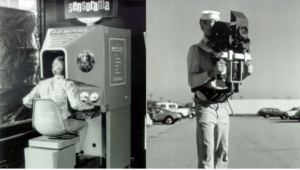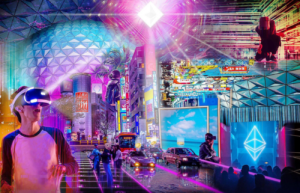Editor’s Note:
To prevent the reader from getting confused, we have to explain the topic of the article in more detail. The title of our article is ambiguous, because virtual reality technologies are often used for exhibitions of creative works – paintings, animations, cartoons. We will have an article about VR applications in that vein, but later. This article, on the other hand, is about how VR has been portrayed in the arts: movies, TV series, literature, that is, in popular culture.
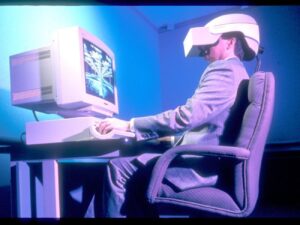
The idea of virtual realities in art. History of the development of the concept
Virtual reality is a relatively young technology. In recent years, it has become truly accessible and mainstream – anyone can have a VR experience with a smartphone and homemade glasses. Moreover, full-fledged VR sets (helmets, controllers) continue to become cheaper, and in time they will become as accessible as computers.
There are incredibly many applications for virtual reality. 10-15 years ago, VR and AR were used only by some advanced engineering, industrial and IT companies, but now anyone can use virtual reality, but that was not always the case.
Just twenty years ago and earlier, VR was more science fiction than everyday reality – we could see examples of such realities in the arts – movies, books, advertising. Let’s go back to the origins, namely to the fictional ideas on the basis of which the concept of VR-technology was created.
A brief background to the emergence of VR
The word “virtual” itself is far from new – it appeared in English and Latin at the end of the 15th century. Virtual could refer to any object or phenomenon of which they had a clear idea, but which did not exist in reality. The modern meaning of the word acquired in the XX century, for the first time the phrase “virtual reality” was used by French playwright Antonin Artaud. In his essays in Theatre and its Double, he pondered how virtual reality technology could help create effective and spectacular sets during plays in theaters. In the 1950s, he was working on creating VR technology for theaters, but not computers (suitable ones did not yet exist), but “telespheres” working in the manner of projectors were used to achieve the results.
The idea that computers could be used to create virtual realities began to be actively developed in the 1970s. At that time, shows, films and books appeared, either describing full-fledged virtual worlds or showing how characters use VR in everyday life, e.g. for remote communication. The art was followed by business: existing technology companies opened departments to work with VR. There were even entire startups dedicated to the development of such technology.
Of course, each author and filmmaker had their own vision of the technology. Someone created too fantastic stories using virtual reality technology, while others were focused on more down-to-earth and practical concepts. It is worth noting that many movies and books hit the mark – what we saw on the screens fifty years ago has become reality today.
We will note the most significant works that have been most popular or distinguished for their uniqueness and, as it turned out in the end, plausibility.
In our list, we mention works in which the concept of virtual reality is based on computer technology. There are many good books and movies where virtual reality is understood as parallel worlds, or, for example, human dream worlds, but they do not fit the topic of our article.
VR in cinematography
Filmmakers thought early on about how they could help the viewer become more immersed in the plot of the picture – almost as soon as the first movie theaters appeared. The first serious attempt to create virtual reality was made by Morton Heilig – in the 1950s he assembled the Sensorama, a combined mechanical device consisting of stereoscopic glasses, fans, a controlled chair, and an odor simulator. The Sensorama was used to show ultra-realistic movies, and is essentially the forerunner of modern 5D movie theaters.
In addition to Heilig, other filmmakers and inventors have pursued such ideas. We mention such projects to show that filmmakers not only made films about virtual reality, but also tried to create that very VR in the form of working technology.
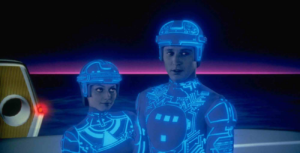
One of the first films to accurately anticipate VR was “Tron”, released in 1982. In the story, the main character is placed in a virtual digital world where he has to survive in gladiatorial battles. After that, he has to get out of there, and it helps him in this artificial intelligence, which is responsible for the “safety” of the virtual games.
Even earlier, in 1973, came out the German TV series “World on a Wire”, the plot of which scientists have created a supercomputer, whose main task is to create and maintain a full-fledged virtual world. In the course of the plot, one of the main characters accidentally changes identities with a “digital person” from the simulation.
In 1995 another good VR movie came out, but with a slightly different concept, Strange Days. In this movie, devices were invented that allow you to “record” everything that happens to a person so that others can later “play back” the recording – with all five of the human senses.
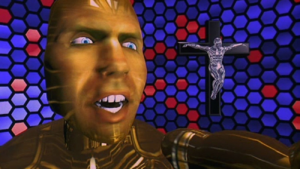
Very close to the modern notion of VR is the 1992 film The Lawnmower. In it, the main character immerses his brother in virtual reality over and over again, trying to cure his mental disability. Eventually he succeeds, but has to deal with the consequences – in short, no spoilers. The movie isn’t bad, but it had a small budget, so it’s hard to take it seriously now.
Our greatest honors go to the trilogy, or rather, already the tetralogy “The Matrix.” These are the most famous films about virtual realities, or more precisely, about computer simulations. It was after the release of “The Matrix” that VR burst into popular culture – the explosive popularity of the classic trilogy seriously contributed to this.

One of the most recent films on the subject is “Player 1 Prepare,” directed by Steven Spielberg. The plot of the picture is built around a virtual world into which people voluntarily immerse themselves in order to escape their gray routine. Each player has his own character who can interact with the virtual world. The remarkable thing about the film is that it shows virtual reality in a realistic way – everything depicted in the film either already exists or is technically feasible in the foreseeable future (15-20 years).
There are many more films about VR – here are the most prominent ones mentioned.
VR in literature
Science fiction and futurologists have written quite a few novels, novellas and articles about virtual realities. Ideas related to VR have been common since at least the 1930s. Of course, many of the authors described virtual reality in cartoonish terms-their representation was not at all the same as what we ended up with.
Nevertheless, many writers did hit the mark and their conception of how virtual reality works coincided with modern technological implementations. We want to mention such writers and their works.
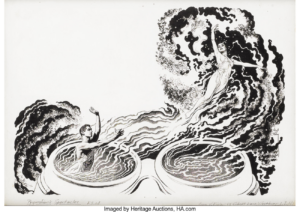
Stanley Weibaum’s Pygmalion’s Spectacles is a science fiction story published in 1935. The main character is a scientist-professor who invented goggles that allow you to immerse yourself in a virtual world. External equipment generated the right sounds, smells and tactile sensations. The story very accurately anticipated the modern development of technology.
The Men Who Awoke is an even earlier work, written by Lawrence Menning in 1933. It mentions virtual reality sporadically; in the book, a person was connected to the VR world through a surgical procedure similar to what happened in The Matrix.
One of the most famous books featuring the technology is Neuromancer by William Gibson. This book is considered the beginning of the cyberpunk genre in general and one of the most iconic on the subject of VR. The other book in this genre is “Avalanche” by Neal Stephenson, in which the creator of the metaworld must fight the virus that consumes it. What these two books have in common is that the virtual realities in them are not used by people as an adjunct to real life, but as a substitute for reality – in VR the characters literally live.
There are many more stories, novels and novels about virtual reality – it is easier to write a book on the subject than to make movies, and science fiction and futurologists have long been interested in the idea of VR, so there have been a lot of works written on the subject. We’ve mentioned the most iconic ones.
VR in video games
Any video game can be called virtual reality – albeit with certain compromises. The old games (before the 3D epoch) could hardly claim the title of simulation, but the further the game industry progressed the more the video games corresponded to the term “VR”. conditional Tetris and Ping-Pong do not evoke associations with VR at all, but Half-Life: Alyx is a synonym to the “virtual reality” concept.
Of course, we talked about two extremes – we compared the first video games to a high-budget modern project developed specifically for VR-helmets. This is not a valid comparison, as there is a chasm of thousands of different video games between HL Alyx and Tetris.
Any 3D game can be seen as a virtual world, and quality 3D games have been surprising the community for a long time, and even longer they managed to keep players’ interest in principle, but now times have changed – now not many people can be surprised by cool graphics and advanced gameplay – people are hungry for more.
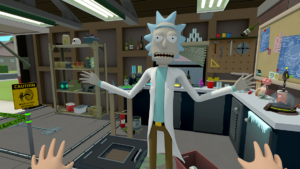
VR and AR gives them that opportunity. A new trend in video games is full or partial integration with virtual reality. Over the past five to seven years, a large number of video games designed to play with VR glasses or a VR helmet have appeared. Only a few of them are big AAA projects with big budgets. Mostly developers created short games with simple gameplay – primitive representatives of different genres.
Not so long ago everything changed. Dizzying success of Half-Life: Alyx from Valve inspired confidence in managers of big gaming campaigns and now almost every big studio create their own VR-development teams to create new projects with big budgets.
In the next few years, the VR industry will add dozens of AAA video games, but so far there is still not much content in VR. This is due to the additional difficulties in developing and adapting games for VR, as well as the fact that relatively few potential customers have VR equipment (helmets or glasses). Once VR sets become cheaper and more accessible, studios will start making more games.
Public Response.
Virtual reality has long been an underground phenomenon. They knew about it, but it was only of interest to a narrow circle of science fiction, computer and cyberpunk fans. In the mass consciousness such a concept did not yet exist, and the early films did not have a significant impact on pop culture.
Everything changed at the end of the 90s. That is when “The Matrix” came out, the first helmets and glasses appeared, and video games flourished, which, in fact, are the very same simulation, albeit a simplified, scripted one. “The Matrix,” the games and working examples of the technology were proof that the introduction of VR is not science fiction, but a matter of time.
At the dawn of the new century, the idea of virtual realities is no longer unbelievable. Every year there are new movies, books, and games about VR, not to mention the fact that tens of millions of people around the world use virtual realities in their professional, creative, and entertainment activities.
What does the future hold for us?
We can say with great confidence that the VR market will grow exponentially in the next few years. The cost of VR helmets will go down, so more people will have access to the technology. This, in turn, will encourage corporations to develop VR further: new content (interactive movies, games) and new applications of the technology will appear. There will be a lot of excitement around VR, and the industry will be full of money, ideas and innovations.
We are seeing these trends right now. Almost 20% of Americans have virtual reality helmets, and literally everyone creates content for VR – both indie developers and the world’s largest corporations: Mark Zuckerberg announced the creation of the Metaworld.
In recent years, a number of special startups have emerged that are trying to create CR (Cinematographic Reality) technology. Roughly speaking, this is a set of tools that will allow the creation of full-fledged VR movies that are fully or partially made in virtual reality using computer graphics. More and more often in the movies started to use AR or Augmented Reality – when the frames are shot in the real world, but the post-processing turns out so that the characters interact with virtual objects. You can read more about such developments in our basic article “New realities – all about VR, XR, AR and MR”.

